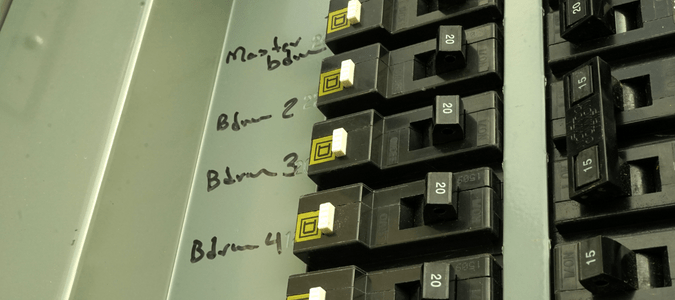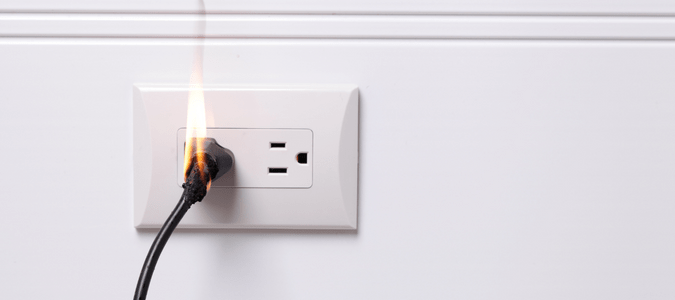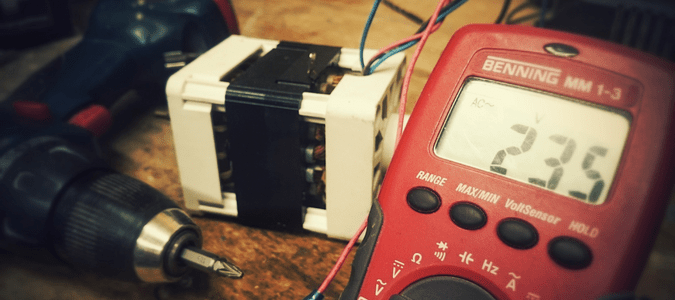Much like our brains function by sending electrical impulses to control the various parts of our bodies, your home’s electrical panel sends electricity to various parts of your house.
The electrical panel (often referred to as the “breaker box”) is a vital part of keeping the electricity flowing properly through your home. Unfortunately, problems can arise and these issues can be especially dangerous and expensive. In addition to the fire danger, electrical panel issues can lead to damage or even destruction of any plugged-in appliances or electronic devices.
Due to the hazards that come with dealing with electricity, you should always contact a licensed electrician when facing power issues in your home.
Common Issues in Bad Electrical Panels
There are several subtle (and not-so-subtle) hints that your electrical panel might have a problem.
Here are four of the most common signs of an electrical panel issue.
Flickering Lights
It’s pretty normal for lights to flicker or go out in stormy weather, but when they’re doing so for no apparent reason, it could be a sign of a bigger problem.
Flickering occurs when the electrical flow to a lightbulb cuts off for just milliseconds at a time. It’s your bulb turning off and back on again so quickly that the filament begins to fade before surging back to life. Again, perfectly normal during certain circumstances, but not when it seems to happen often and without obvious reason.
It can signal that something’s wrong, typically somewhere between the bulb and the breaker in the electrical panel that sends power to that room.
If it’s happening with all of the lights throughout your home, it’s almost certainly an electrical panel issue.
Tripping Breakers
Another sign of electrical issues is breakers tripping frequently, especially when it’s happening with many breakers or one that you’ve recently replaced. This issue usually arises with older panels, or those that lack the capacity to handle your current amount of electrical usage.
Another indicator is if a breaker, or breakers, seem to be tripping for no reason.
Typically, a breaker trips when an additional drain is added to the line, like the AC turning on or a hair dryer being used. This is due to age or insufficient capacity.
Note: Frequently overheating appliances can signal electrical panel issues or the need to diagnose the appliance for repairs.
If it’s happening when nothing is being turned on, it could be a more serious issue, leading to some major repairs or even replacement of the electrical panel.
Electric Shocks
Even just a little tingle can mean poor grounding, bad wiring or panel problems. That little shock might be more annoying than it is dangerous, but there’s no telling how powerful the next one could be. This is another good reason to rely on a professional to inspect and test your electrical panel and wiring and grounding system for you.
Burnt Spots or Smells
An overheating circuit can leave scorch marks on an electrical panel, and wall outlets can leave burns or smoke stains on covers and walls. This overheating can emit odors of burnt insulation and wiring, as well.
If you notice burns, smoke stains or a burning smell, especially on or around your electrical panel, it needs to be replaced.
Brands of Electrical Panels That Should be Replaced
Older homes often mean older or outdated electrical panels which, for both safety and efficiency, should be replaced. The recommended service life of an electrical panel is 20 to 30 years. If your home is older than that, and the panels have never been updated, it’s time to start thinking about it.
When checking on the date of installation, you should also keep an eye out for the make, model and electrical capacity of your current panel. Some older brands of electrical panels are notoriously defective, some even being the cause of house fires.
If you have one of the following brands, it could present a safety hazard and should be replaced as soon as possible:
FEDERAL PACIFIC
From the 1950s to the 1990s, Federal Pacific was a common brand of breakers and panels across the United States. However, recent testing has shown that as many as one in four of those breakers may not trip properly when overloaded, leading to the risk of home fires and property damage.
ZINSCO & SYLVANIA
Like Federal Pacific, 25% of all Zinsco circuit breakers may overheat. Portions of these breakers can melt, leading to a failure to trip in response to an overcurrent. This leaves both homes and homeowners at risk of electronic property damage, electrical shock and fire.
Electrical panels sold by Sylvania were also common in the U.S. in the 1960s and 1970s.
These panels were originally manufactured by Zinsco, and this line was bought out by Sylvania, who simply added their logo to them.
If you currently have one of these breakers, your home may be deemed uninsurable, you could face higher premiums and future insurance claims may be denied.
ITE/BULLDOG PUSHMATIC
Manufactured in the 1930s, these breakers and panels are rare and practically archaic. You can’t even buy replacement parts for them anymore!
Pushmatic’s breakers lack a magnetic tripping mechanism, which seems to be one of the major reasons for frequent failures. Being grease-fed, they also tend to dry out, making them extremely stiff and difficult to operate. It was also common for these breakers to remain on even though they showed as off.
If you have one of these ITE/Pushmatic panels or breakers, it’s time for an electrical panel upgrade.
Note: The older Pushmatic panels aren’t compatible with the modern Pushmatic breakers currently being sold. Many homeowners have reported damage after trying to force these new breakers to fit.
Pros and Cons of Upgrading Your Electrical Panel
As mentioned, a home electrical panel has a finite lifespan of 20 to 30 years. Proper upkeep and smart electricity practices may squeeze a few more years out of it, but at some point, it becomes a safety hazard to your home and family.
Here are a few pros and cons to consider:
Pros of Upgrading an Electrical Panel
-
Increase the value of your home.
-
Instantly improve your home’s overall electrical performance.
-
Extend the lifespan of your electrical equipment and appliances.
Cons of Upgrading an Electrical Panel
-
Upgrading an electrical panel can be quite expensive, depending on labor, the replacement unit, complexity and the materials needed.
-
It can create black-out time for the electricity-needy components of your home and lifestyle. Things like computers, chargers, home-health devices, television services and cooking appliances will be out for the duration of the project.
What Goes into Replacing Electrical Panels
Most homeowners’ experience with electrical panels is limited to opening the door of the panel and flipping a disabled circuit breaker back on. The next most common activity is removing and replacing circuit breakers. However, even many DIYers are hesitant to dig any deeper into their electrical system and choose instead to contact a professional electrician.
When it comes to a big project like replacing an electrical panel, many are curious about what a licensed electrician will do during the appointment.
Process for Replacing an Electrical Panel
Just to give you some idea of what’s involved in replacing an electrical panel, here are the basic steps that an electrician would take during this project:
-
Determine your power consumption needs
-
Find the best replacement panel for your current and future needs
-
Coordinate with your utility provider and local authority for permits if required
You’ll need to pre-schedule with your electrical provider to turn off power to your grid location so that your electrician can start shifting wires from the old panel to the new one.
-
Flip the main breaker on the old panel to the OFF position
- One by one, disconnect the wires from each breaker in the old box
- Remove the old panel and shift it out of the way
- Install the new panel (not yet wired) tightly into place
-
Install all of the current breakers (standard, GFCI, & AFCI)
-
Connect each wire to the breakers in the new box
Once everything is back in place, and your grid power has been restored, your electrician can reactivate the electrical panel.
This procedure requires electricians to switch the main breaker back on first (all the individual circuit breakers remaining OFF) and test the main breaker for proper voltage. Then, switch the individual breakers back, one by one, to avoid a potentially dangerous power surge to your system.
If you have concerns about the age of your electrical panel or any part of your electrical system, or if you’re experiencing some of the common issues related to electrical panel problems, it’s no time to procrastinate.
And, though you may be tempted to take a swing at it yourself, unless you’re an electrician yourself, you really should leave this one to a licensed electrician.
You, your family and your home are just too important to risk it.
ABC Can Help with Bad Electrical Panels
Replacing a bad electrical panel on your own can be daunting, especially without the proper tools and equipment. Contact our experts at ABC Home & Commercial Services. Our licensed electricians will help repair any electrical issues you may be having or replace your home’s electrical panel if necessary.



